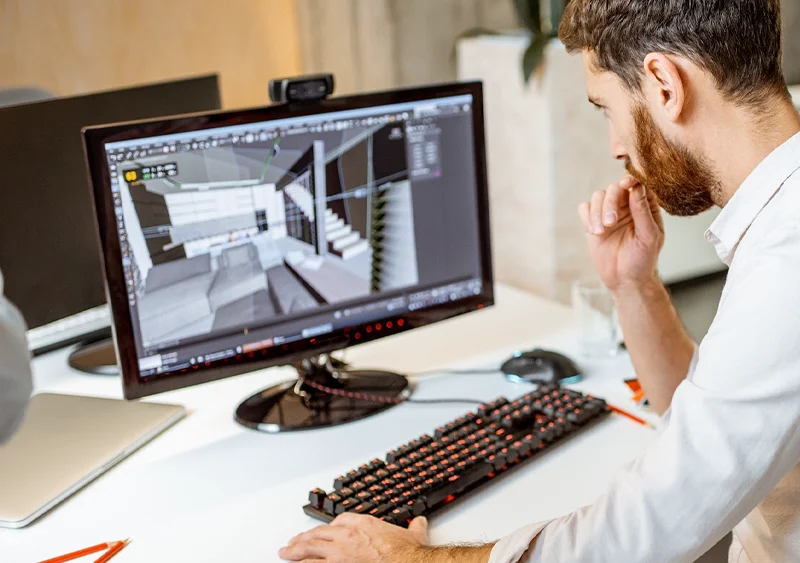Outsourcing 3D Architectural Visualization: Key Benefits & Expert Tips
The Future of 3D Architectural Visualization: Why Outsourcing is the Smart Choice

7 MIN READ
March 12, 2025

Written By
Harish Selvaraj
Great architecture is not just the concrete outcomes. It is about how well a project is presented. Investors, clients, and buyers need to see the vision before construction begins. This is where 3D architectural visualization becomes essential.
Building an in-house team for this can be expensive and time-consuming. Outsourcing offers a faster, more cost-effective solution. It provides access to skilled professionals, advanced technology, and quicker turnaround times without the overhead of an internal team.
For firms aiming to enhance project presentations, speed up approvals, and impress clients, outsourcing 3D visualization is not just a choice. It is a strategic advantage.Let’s explore why.
Why 3D Architectural Visualization is Essential
Architectural designs are only as powerful as their presentation. A blueprint alone cannot capture the full vision of a project. Clients, investors, and stakeholders need to see realistic, immersive visuals to understand the scale, lighting, and materials before construction begins.
3D architectural visualization brings designs to life with high-quality renders that showcase every detail. It helps architects refine concepts, identify potential design flaws, and make informed adjustments early. This not only improves project accuracy but also saves time and reduces costly revisions.
Developers use 3D renders for pre-sales, marketing campaigns, and faster approvals. With lifelike imagery, projects gain traction, attract buyers, and stand out long before the first brick is laid.
5 Key Benefits of Outsourcing 3D Architectural Visualization
Outsourcing 3D architectural visualization is not just about cost-cutting. It is about efficiency, expertise, and delivering high-quality visuals without the burden of an in-house team. In a field where presentation matters as much as design, having top-tier 3D renders can be the difference between securing a client and losing them to a competitor.
Here is why more firms are choosing to outsource.
Eliminates Overhead Costs While Maintaining Quality
Hiring an in-house team means expensive software, powerful hardware, and a skilled workforce, all of which come with long-term costs. Not every firm has the resources to maintain an internal visualization team.
Outsourcing provides access to professional 3D artists and the latest technology without these financial commitments.
- No need for expensive software licenses and high-performance rendering machines.
- Flexible pricing based on project scope rather than fixed salaries.
- Consistently high-quality output from experienced professionals.
Delivers Faster Turnaround Without Compromising Detail
Architectural projects often work under tight deadlines, and slow visualization can delay approvals and marketing efforts. An outsourced team is focused solely on delivering fast, high-quality renders so architects and developers can move forward without bottlenecks.
Unlike an in-house team juggling multiple tasks, outsourced specialists streamline the process. They have refined workflows that ensure:
- Faster execution without compromising accuracy.
- Quick revisions based on client feedback.
- The ability to handle large-scale projects without slowing down core operations.
Access to Advanced Tools and Cutting-Edge Techniques
3D architectural visualization is evolving fast. What was considered high-end rendering five years ago is now standard. Keeping up with these changes means constant investment in new software, rendering engines, and photorealistic techniques. Outsourcing partners specialize in staying ahead of these trends.
- Real-time rendering, AI-driven textures, and hyper-realistic lighting.
- Advanced VR/AR integrations for immersive client experiences.
- A global talent pool of experienced visualization experts.
Allows Architects to Focus on What Matters Most
Every hour spent on rendering is time taken away from core design and planning. While visualization is critical, it should not become a distraction from the architectural process itself. Outsourcing ensures that:
- Architects and designers stay focused on conceptualization and execution.
- Project managers can prioritize approvals and client presentations.
- Marketing teams get professional visuals without additional workload.
Boosts Client Engagement and Pre-Sales Efforts
A well-executed 3D render is more than a visual tool. It is a powerful marketing asset. Developers use photorealistic renders in brochures, websites, and investor presentations to sell properties before they are even built.
- High-quality visuals improve client presentations and investor pitches.
- 3D walkthroughs and VR experiences create stronger emotional connections with buyers.
- Visually stunning projects gain more traction in competitive markets.
Read our blog on 3D Architectural Visualization - Explained for a comprehensive understanding.
How to Choose the Right 3D Visualization Partner
Not all 3D visualization providers have the technical skills or architectural expertise needed to bring a project to life with precision. The key is finding a partner who understands your industry, delivers high-quality visuals, and aligns with your workflow.
So, how do you make the right choice? Instead of simply looking at price or portfolio, focus on experience, technology, reliability, and scalability. Here is what to consider.
Industry Expertise Matters More Than You Think
3D visualization is used across many fields, from gaming to product design. A company specializing in architectural visualization understands space, scale, and real-world material behavior. They know how to create renders that sell projects, impress investors, and meet industry standards.
- Check their experience in real estate, interior design, or urban planning.
- Look for projects that match your style—high-end residential, commercial spaces, or industrial developments.
- Ask if they understand architectural lighting, material realism, and environmental factors.
A 3D model is more than just an image. It is a communication tool, and the right team knows how to make it work for your project.
A Portfolio Tells Half the Story—Dig Deeper
Most firms showcase their best work, but does it align with your expectations? Instead of just looking at their renders, analyze their depth, realism, and level of detail.
- Do their renders have lifelike textures, proper lighting, and realistic shadows?
- Are the spaces visually engaging, or do they look artificial?
- Do they demonstrate an understanding of functionality and storytelling in architecture?
Some firms create over-processed visuals that look impressive but lack practical accuracy. If you want realistic marketing visuals or technical precision for approvals, ensure the firm can deliver both.
Technical Capabilities Can Make or Break a Project
Software and technology evolve rapidly, and high-quality visualization requires more than just basic rendering skills. The right firm should be proficient in:
Top-tier software like 3ds Max, Blender, V-Ray, or Unreal Engine.
Photorealistic rendering techniques, including ray tracing and HDR lighting.
VR/AR compatibility for immersive real estate experiences.
A team that uses cutting-edge tools will produce superior visuals, handle complex projects, and future-proof your assets.
Process and Communication Are as Important as Skills
Technical skills mean nothing if the workflow is disorganized. Clear timelines, structured revisions, and open communication ensure a smooth collaboration.
- Do they offer a transparent workflow with defined milestones?
- How often do they provide updates or preview drafts?
- Are they responsive to feedback and willing to make adjustments?
An experienced firm will have standardized project management practices that minimize errors and keep things on track.
Scalability and Turnaround Time—Can They Keep Up?
Some projects require a single render, while others need an entire portfolio of visualizations. A partner should be able to scale with your needs, whether you have a small residential project or a multi-phase commercial development.
- Do they have the resources to handle large-scale projects without delays?
- Are they flexible with urgent requests or phased deliverables?
- Can they maintain quality even under tight deadlines?
A great visualization partner adapts to your needs, not the other way around.
Pricing Should Reflect Value, Not Just Cost
The cheapest option is rarely the best. Focus on value over price. Higher-quality renders enhance presentations, speed up approvals, and improve marketing efforts, ultimately bringing a higher return on investment.
Before choosing a firm:
- Request detailed pricing with deliverables outlined.
- Check if pricing includes revisions, licensing rights, and additional services.
- Compare costs against the level of quality and expertise offered.
Investing in high-quality visualization is a long-term advantage, not just a one-time expense.
Best Practices for a Successful Outsourcing Partnership
- Be Specific About Your Needs – A vague project brief leads to delays and miscommunication. Share clear expectations about style, resolution, formats, and deadlines upfront.
- Work with Experts, Not Just a Vendor – A reliable outsourcing partner should feel like an extension of your team. Choose a firm with a deep understanding of architectural visualization, not just 3D modeling.
- Keep Communication Simple and Frequent – Regular updates prevent surprises. Use structured check-ins and provide timely feedback to keep the project moving efficiently.
- Review, Refine, and Approve in Stages – Instead of waiting for the final render, approve drafts at key milestones. This ensures quality, minimizes revisions, and keeps the project aligned with your vision.
Conclusion
Most architecture firms know the struggle. Tight deadlines, demanding clients, and the constant need for high-quality visuals. Yet, relying on in-house resources often leads to slow turnarounds, inconsistent results, and unnecessary overhead costs.
The real challenge is not just creating 3D renders but producing them at scale, with precision, and within budget. Outsourcing is not about cutting corners. It is about expanding capabilities, speeding up approvals, and delivering visuals that sell projects before they break ground.
ZealousXR, India’s largest 3D Rendering company, has been helping clients on 3D rendering, modeling, animation, visualization, and image editing services to transform ideas into stunning, high-quality visuals
About the writer :
Harish Selvaraj heads Zealous Services' 3D animation and modeling projects, bringing over 17 years of experience in ... delivering top-tier 3D solutions. He collaborates directly with clients to ensure their ideas are transformed into powerful 3D results that meet both creative and business goals. Harish is deeply involved in driving sales and managing teams, making sure that each project delivers on quality while helping businesses grow through impactful 3D designs.
Read MoreFrequently Asked Questions (FAQ)
Why should architecture firms outsource 3D visualization instead of doing it in-house?
Outsourcing eliminates the need for expensive software, high-end hardware, and dedicated staff. It provides access to experienced 3D artists, faster turnaround times, and high-quality renders without the ongoing overhead costs of an in-house team.
How can outsourcing improve project efficiency?
Professional 3D visualization firms follow structured workflows, ensuring faster delivery, fewer revisions, and consistent quality. This allows architects and developers to focus on core tasks like design, planning, and client presentations.
Is outsourced 3D visualization cost-effective?
Yes. Instead of investing in costly rendering software and training staff, firms pay only for the services they need. Outsourcing allows for flexible pricing models that align with project budgets while maintaining high-quality results.
How do I ensure quality when outsourcing 3D visualization?
Choose a provider with a strong portfolio, expertise in architectural visualization, and a transparent workflow. Reviewing test renders and maintaining open communication ensures the final output meets expectations.
Can 3D visualization help with real estate marketing and sales?
Absolutely. Photorealistic 3D renders, virtual walkthroughs, and AR/VR experiences enhance property marketing efforts by giving potential buyers a clear and immersive preview before construction even starts.